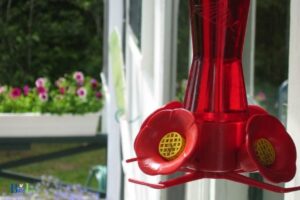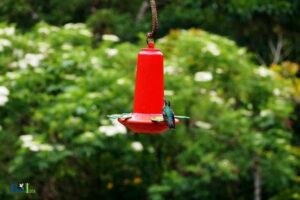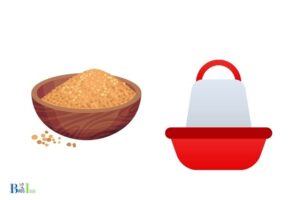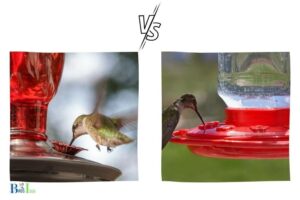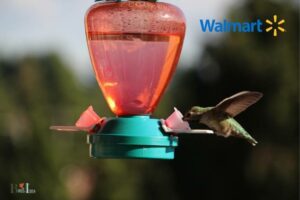How to Clean Hummingbird Feeder Audubon: Mild Soap!
To clean a hummingbird feeder Audubon style, follow a simple cleaning routine that includes using a mild soap solution, rinsing thoroughly, and air drying before refilling with fresh nectar.
Cleaning your hummingbird feeder is essential to maintaining the health and well-being of the hummingbirds that visit your feeder.
Audubon recommends cleaning the feeder at least once a week, or more frequently during hot weather or if the nectar becomes cloudy or develops mold. This will prevent the growth of bacteria and mold that can harm the birds.
Make sure to reach all nooks and crannies where mold and bacteria might hide. Rinse the feeder parts multiple times with warm water to remove any soap residue.
Finally, allow the feeder to air dry completely before reassembling and refilling with fresh homemade or store-bought nectar.
10 Steps to Clean Hummingbird Feeder Audubon
| Step | Description |
| 1 | Gather necessary materials: warm water, mild dish soap, soft-bristle brush, bottle brush, and a clean towel |
| 2 | Disassemble the hummingbird feeder, removing all removable parts |
| 3 | Rinse the feeder with warm water |
| 4 | Add a few drops of mild dish soap into the feeder and fill it with warm water |
| 5 | Use the soft-bristle brush to scrub the feeder’s interior and the bottle brush to clean any narrow openings |
| 6 | Clean the feeding ports by scrubbing them gently with the soft-bristle brush |
| 7 | Rinse the feeder thoroughly with warm water to remove any soap residue |
| 8 | Dry the feeder with a clean towel, or air dry it by hanging it upside down |
| 9 | Reassemble the feeder and refill it with fresh nectar |
| 10 | Hang the cleaned and refilled feeder in your preferred location for hummingbirds to enjoy |
Key Takeaway
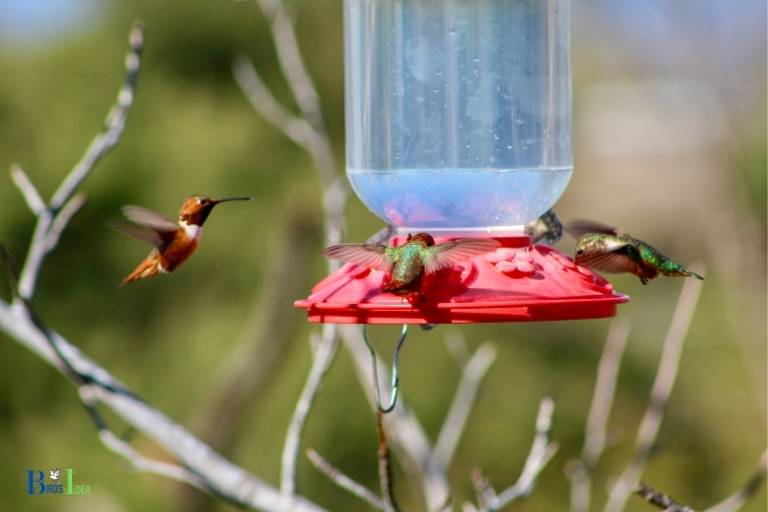
Five Facts About: Clean Hummingbird Feeder
Supplies You Need
Hummingbirds are incredible creatures known for their impressive hovering skills and their love for sweet nectar.
However, if you own a hummingbird feeder, it’s important to know that it needs to be cleaned regularly to prevent the growth of harmful bacteria and mold.
In this section, we’ll discuss the supplies you need and the safety precautions to take before cleaning.
List Of Supplies Needed And Why They Are Important
Before you start cleaning your hummingbird feeder, it’s important to make sure you have all the necessary supplies.
Here’s a list of what you’ll need and why each item is important:
- Rubber gloves: To protect your hands from the cleaning solution and any potential bacteria.
- Sponge or brush: To scrub the inside of the feeder and remove any mold or residue.
- Mild dish soap: To clean the feeder without harming the hummingbirds.
- Bleach or white vinegar: To disinfect the feeder and kill any bacteria or mold that may be present.
- Hot water: To help dissolve any sugar residue left in the feeder and to thoroughly rinse the inside.
- Paper towels or clean cloth: To dry the feeder after cleaning, as any remaining moisture can be a breeding ground for bacteria.
Safety Precautions To Take Before Cleaning
While cleaning your hummingbird feeder, it’s important to take some safety precautions to protect both yourself and the hummingbirds.
Here are some tips to keep in mind:
- Wear rubber gloves to protect your hands from any chemicals or bacteria in the feeder.
- Remove any remaining nectar from the feeder and dispose of it before cleaning.
- Do not use harsh chemicals or cleaners that could harm the hummingbirds.
- Use hot water to wash the feeder thoroughly, rinsing it well to remove any residue or cleaning solution.
- Allow the feeder to dry completely before refilling it with nectar.
By following these precautions and using the necessary supplies, you can keep your hummingbird feeder clean and safe for these amazing birds to enjoy.
Step By Step Cleaning Process
Hummingbirds are delightful creatures to watch and feeding them is a joy. However, cleaning their feeder can be a less-than-pleasant task.
To help, we’ve created a step-by-step guide on how to properly clean your audubon hummingbird feeder. Let’s dive in!
Step 1: Disassembly Of The Audubon Feeder
To begin, you’ll need to disassemble your hummingbird feeder.
Here are the key points to remember:
- Remove any remaining nectar from the feeder.
- If there are any bees or ants on the feeder, shoo them away before disassembly.
- Separate the feeder’s parts.
Step 2: Soaking In Hot Water
This is the step where the magic happens. Soaking your feeder in hot water helps loosen any residue and makes cleaning easier.
Here’s what you need to know:
- Fill a bucket or sink with hot water and add a small amount of white vinegar or mild soap.
- Soak all parts of your feeder for 30-60 minutes.
- Use a soft brush to scrub away any dirt or mold buildup. Note: Never use harsh chemicals or bleach.
Step 3: Proper Cleaning Of Parts
Now it’s time to clean each individual part of the feeder, paying close attention to detail.
Here are the steps to follow:
- Thoroughly rinse each part with running water.
- Use a q-tip to gently clean small and hard-to-reach areas.
- For any particularly tough spots, try using a toothbrush or pipe cleaner.
- Rinse each part one more time with running water.
Step 4: Drying And Reassembly Of The Feeder
Before reassembling your hummingbird feeder, make sure all parts are completely dry.
Here’s what you should do:
- Use a clean, dry towel to pat each part dry.
- Allow each part to air dry until there is no moisture left.
- Reassemble the feeder by putting all parts back together.
Step 5: Cleaning Of The Surrounding Area And Disposal Of Dirty Water/Solution
The final step in cleaning your audubon hummingbird feeder is cleaning the surrounding area and disposing of any dirty water or solutions.
Here’s how to do it:
- Wipe down the area where the feeder was hanging to remove any residue or droppings.
- Dispose of the dirty water and cleaning solution in a drain or toilet. Note: The cleaning solution should be similar to that used in step 2 (i.e., mild soap or vinegar).
- Rinse the bucket or sink thoroughly with hot water to remove any lingering residue.
Cleaning your audubon hummingbird feeder can be a simple and enjoyable task with the right steps. Remember to always wear gloves and avoid using harsh chemicals or bleach.
By following our step-by-step guide, you can ensure your feeder is a safe and healthy place for hummingbirds to visit.
Happy cleaning!
Frequency Of Cleaning
Important Reminders On How Regular Cleaning Of The Feeder Can Positively Affect The Birds That Visit The Feeder
Regular cleaning of your hummingbird feeder is essential not only for the feeder’s durability but also for the health of the birds that visit.
Cleaning your feeder prevents harmful bacteria and mold from building up and ensures that your feathered friends have a healthy environment to enjoy their meals.
Factors That Affect The Frequency Of Cleaning
The frequency at which you need to clean your hummingbird feeder depends on several factors, such as the location and weather conditions in your area.
Here are some things to keep in mind when determining how often to clean your feeder:
- Location: If your feeder is in direct sunlight, you may need to clean it more frequently as the nectar may spoil quicker. Similarly, if your feeder is in a more humid area, it may attract more mold and bacteria, requiring more frequent cleaning.
- Weather: During hotter months, the high temperatures can cause the nectar to spoil more quickly, necessitating more frequent cleaning. Similarly, during rainy seasons or periods of high humidity, your feeder may collect more moisture, leading to mold buildup and requiring more frequent cleaning.
- Frequency of use: If your feeder is frequently visited by hummingbirds, it may require more frequent cleaning as the nectar may be depleted faster, leading to buildup and spoilage.
- Type of nectar: The type of nectar and the amount of sugar used can also affect the frequency of cleaning. Higher sugar concentrates and artificial additives may cause faster spoilage and buildup, requiring more frequent cleaning.
Cleaning your hummingbird feeder is an essential aspect of maintaining a healthy and enjoyable environment for your feathered friends.
By keeping these factors in mind when determining how often to clean your feeder, you can ensure that your hummingbirds have a clean and safe space to enjoy their meals.
FAQ On How To Clean Hummingbird Feeder Audubon
How Often Should I Clean My Hummingbird Feeder?
What Is The Best Way To Clean My Hummingbird Feeder?
Can I Use Bleach To Clean My Hummingbird Feeder?
How Do I Prevent Mold From Growing In My Hummingbird Feeder?
Conclusion
Ensuring that your hummingbird feeder is clean and well-maintained is essential for attracting and keeping these beautiful birds in your backyard.
Cleaning your audubon hummingbird feeder may seem like a daunting task at first, but with the right tools and techniques, it can be a simple and quick process.
Regularly cleaning your feeder will not only keep it looking good, but it also ensures the safety and health of our feathered friends.
With these simple steps, you can keep your feeder sparkling clean and ready for your winged visitors.
Remember, cleaning your feeder every few days or at least weekly is critical for a safe and healthy environment for the hummingbirds. So go ahead, put on those gloves and get busy cleaning for those little guys who bring a smile to our faces every day.
Happy feeding!

